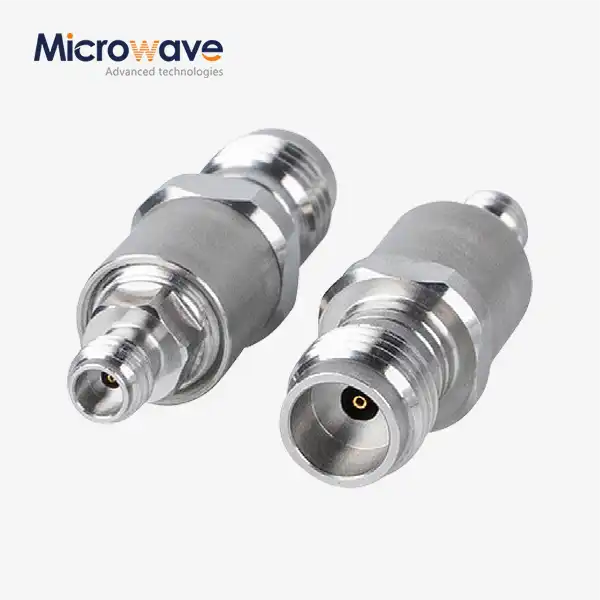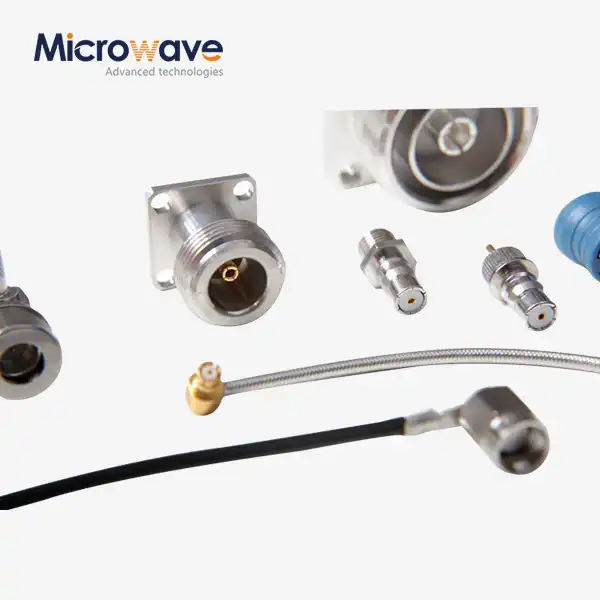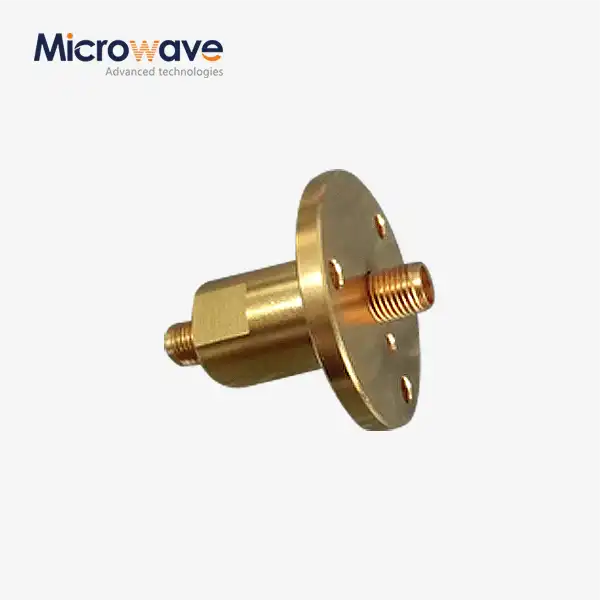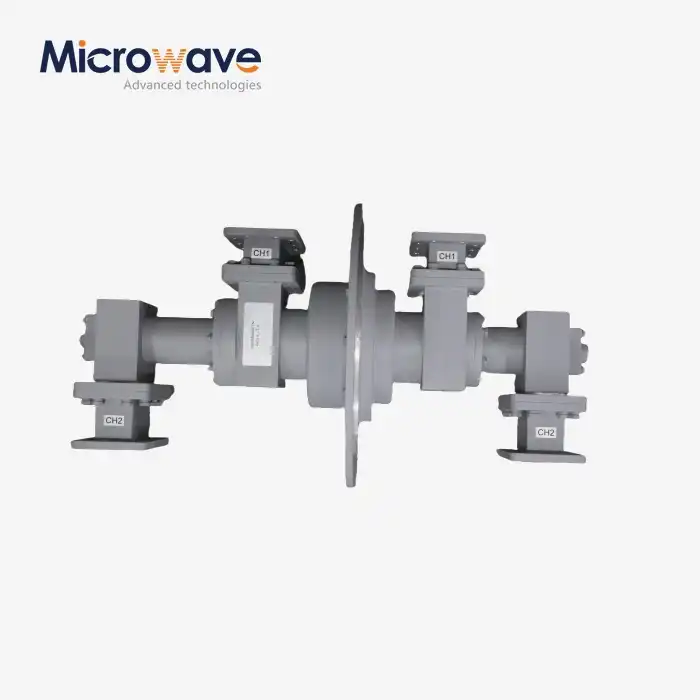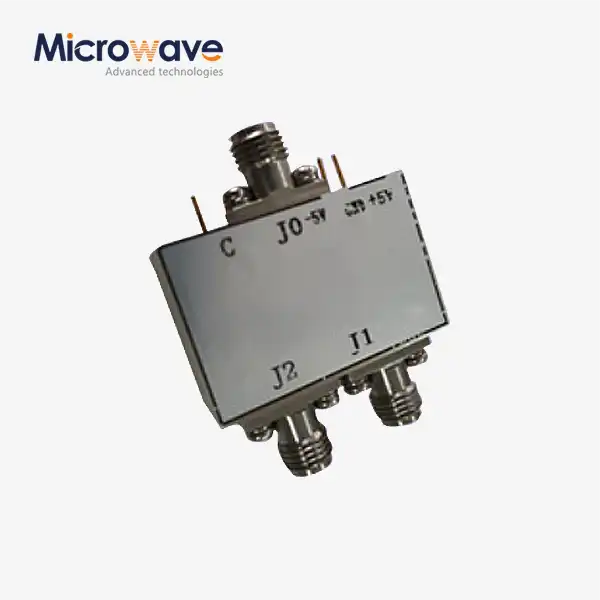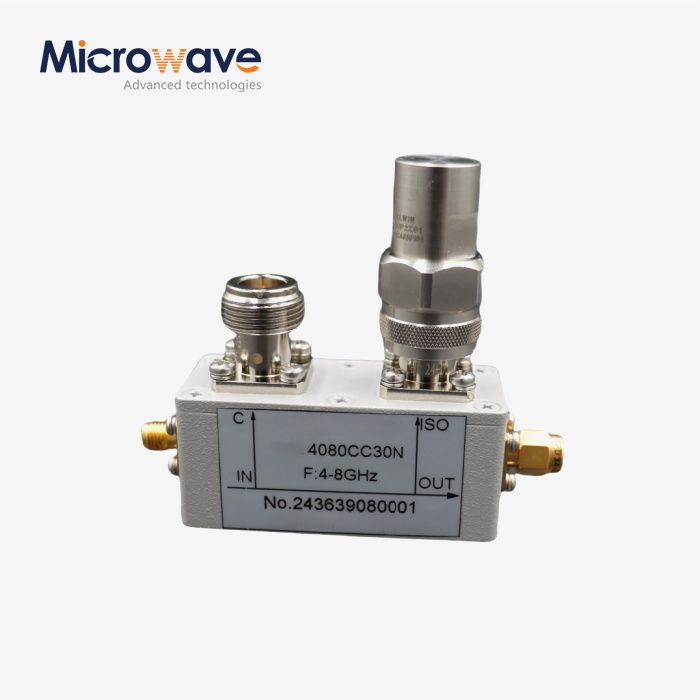How is a Dual Channel Coaxial Rotary Joint different from a single-channel rotary joint?
Dual Channel Coaxial Rotary Joints represent a significant advancement over their single-channel counterparts, offering enhanced capabilities for modern communication and detection systems that demand simultaneous transmission of multiple signals. Unlike single-channel rotary joints that can only transmit one signal pathway between rotating and stationary parts, a Dual Channel Coaxial Rotary Joint enables the simultaneous and independent transmission of two separate RF signals across a rotating interface without interruption or signal degradation. This dual-channel functionality essentially doubles the capacity of conventional rotary joints while maintaining the compact form factor that makes coaxial designs preferable to waveguide alternatives in many applications. At Advanced Microwave Technologies Co., Ltd, our Dual Channel Coaxial Rotary Joint solutions are precision-engineered to deliver superior performance across a wide frequency range from DC to 40 GHz, with exceptional insertion loss characteristics of ≤0.2 dB and VSWR ≤1.25:1, making them ideal for critical applications in satellite communications, aerospace, defense, and industrial automation where reliability and signal integrity are paramount.
Structural and Operational Differences Between Dual and Single Channel Rotary Joints
Advanced Design Architecture
The Dual Channel Coaxial Rotary Joint features a significantly more complex internal architecture compared to single-channel variants. While a single-channel rotary joint typically consists of one signal path through a rotating interface, the dual-channel design incorporates two completely independent signal paths that must maintain isolation from each other while preserving signal integrity across both channels. The engineering challenge of maintaining multiple high-frequency transmission lines in close proximity without cross-talk or interference requires sophisticated electromagnetic field management techniques. Advanced Microwave Technologies Co., Ltd leverages over 20 years of microwave engineering expertise to create dual-channel designs that effectively isolate each signal path while maintaining the compact form factor that makes coaxial rotary joints advantageous over waveguide alternatives. Our dual-channel designs employ specialized concentric conductor arrangements and precision-machined components that ensure consistent electrical performance across the entire rotation cycle. The Dual Channel Coaxial Rotary Joint maintains excellent insertion loss characteristics (≤0.2 dB) across both channels simultaneously, a significant technical achievement compared to single-channel designs where managing loss in just one transmission path presents fewer engineering challenges.
Performance Characteristics Comparison
When comparing performance metrics, Dual Channel Coaxial Rotary Joints demonstrate remarkable capabilities that differentiate them from single-channel alternatives. Single-channel rotary joints typically focus optimization efforts on a single set of performance parameters, whereas dual-channel variants must maintain balanced performance across multiple signal paths simultaneously. At Advanced Microwave Technologies, our Dual Channel Coaxial Rotary Joint solutions deliver consistent performance across both channels with power handling capabilities up to 500W, VSWR ratings of ≤1.25:1, and operational frequencies ranging from DC to 40 GHz. This balanced performance is particularly challenging to achieve as the rotation speed increases, yet our designs maintain signal integrity even at rotational speeds up to 100 rpm. The dual-channel configuration introduces additional complexity in terms of isolation requirements between channels, with our products achieving channel-to-channel isolation typically exceeding 50 dB. Temperature stability presents another critical difference, with dual-channel designs requiring more sophisticated thermal management to maintain consistent performance across a wide temperature range from -40°C to +85°C. These enhanced performance characteristics make Dual Channel Coaxial Rotary Joints significantly more versatile than their single-channel counterparts, particularly in applications requiring simultaneous transmission of control signals and data or multiple data streams.
Size and Integration Considerations
While Dual Channel Coaxial Rotary Joints offer twice the signal capacity of single-channel variants, they achieve this without proportional increases in size and weight. Advanced Microwave Technologies has developed innovative design approaches that enable our Dual Channel Coaxial Rotary Joint products to remain compact and lightweight compared to waveguide rotary joints, making them ideal for applications with strict space and weight constraints. The integration of two signal paths within a relatively compact housing represents a significant engineering achievement, requiring precision manufacturing techniques and advanced materials. Our dual-channel designs typically feature only a modest increase in diameter and length compared to single-channel equivalents, with careful attention to connector placement and orientation to facilitate easy integration into complex systems. This space efficiency becomes particularly important in applications such as satellite communication systems, aerospace equipment, and advanced defense platforms where size and weight constraints are critical design factors. The Dual Channel Coaxial Rotary Joint's ability to handle two independent signal paths without a proportional increase in physical dimensions represents a significant advantage over installing multiple single-channel devices, reducing system complexity, weight, and potential points of failure while improving overall reliability.

Application-Specific Advantages of Dual Channel Rotary Joints
Enhanced Capabilities for Satellite Communications
In satellite communication systems, Dual Channel Coaxial Rotary Joints deliver significant advantages over single-channel alternatives by enabling simultaneous transmission and reception operations through a single rotary interface. This capability is particularly valuable in tracking antenna systems where continuous adjustment is necessary to maintain optimal signal alignment with moving satellites. Advanced Microwave Technologies' Dual Channel Coaxial Rotary Joint solutions are designed to support these demanding applications with broad frequency ranges from DC to 40 GHz, accommodating various satellite communication bands including C, X, Ku, and Ka bands. The dual-channel capability allows for dedicated transmit and receive paths, essential for full-duplex communication systems where simultaneous bidirectional data transfer is required. With insertion loss ratings of ≤0.2 dB, our rotary joints ensure minimal signal attenuation, maximizing system efficiency and effective isotropic radiated power (EIRP) in transmission applications. The high-performance characteristics of our Dual Channel Coaxial Rotary Joint products, including VSWR ratings of ≤1.25:1, contribute to excellent impedance matching, reducing signal reflections and maintaining quality connections for high-data-rate transmissions in both commercial and military satellite operations. Additionally, the robust environmental performance, with operating temperatures from -40°C to +85°C, ensures reliability in the harsh conditions encountered in satellite ground stations and mobile communication platforms.
Strategic Benefits for Defense and Radar Applications
In defense and radar systems, the Dual Channel Coaxial Rotary Joint provides critical operational advantages over single-channel versions by enabling simultaneous signal processing for multiple radar functions or frequency bands. Advanced Microwave Technologies' products are engineered to meet the exacting standards of military applications, with ISO 9001:2008 certification and RoHS compliance ensuring consistent quality and environmental responsibility. The dual-channel design is particularly valuable in modern phased array and multi-function radar systems where one channel might handle primary radar signals while the second manages secondary radar, electronic countermeasures (ECM), or communication functions. The high isolation between channels (typically >50 dB) is essential for preventing cross-talk between radar transmission and sensitive reception circuits. Our Dual Channel Coaxial Rotary Joint solutions support power handling requirements up to 500W, accommodating the high-power radar transmission needs while simultaneously maintaining sensitive reception capabilities. The durability of these components, designed to withstand extreme environments, makes them ideal for deployment in advanced weapon systems, vehicle-mounted radar, shipboard installations, and airborne surveillance platforms. The compact design of our Dual Channel Coaxial Rotary Joint products, despite their dual signal capability, contributes to reduced system weight and size—critical factors in modern military hardware where mobility and stealth characteristics are increasingly important design considerations.
Industrial and Specialized Applications Advantages
In industrial automation and specialized applications, Dual Channel Coaxial Rotary Joints offer substantial benefits over single-channel alternatives by facilitating more sophisticated control and monitoring capabilities in rotating systems. Advanced Microwave Technologies' Dual Channel Coaxial Rotary Joint products enable industrial robots, rotary tables, and automated manufacturing equipment to transmit both control signals and data feedback simultaneously through a single rotary interface, significantly streamlining system design and improving reliability. The dual-channel configuration is particularly valuable in applications requiring continuous rotation while maintaining high-bandwidth data connections, such as in medical imaging equipment (CT scanners), radar simulators, and advanced test equipment. With rotational speeds supporting up to 100 rpm, our dual-channel solutions accommodate a wide range of industrial motion requirements without compromising signal integrity. The robust design characteristics, including operational temperature ranges from -40°C to +85°C, ensure reliable performance in challenging industrial environments including manufacturing floors, outdoor installations, and specialized testing facilities. The customization options available for our Dual Channel Coaxial Rotary Joint products allow for tailored solutions meeting specific frequency requirements, connector types, and mounting configurations—flexibility that single-channel designs often cannot match without requiring multiple separate components. This adaptability makes dual-channel rotary joints particularly valuable in emerging applications such as wind turbine monitoring systems, automated guided vehicles (AGVs), and advanced industrial Internet of Things (IIoT) implementations where multiple data streams must be maintained across rotating interfaces.

Technical Implementation and Performance Considerations
Signal Integrity Management
Managing signal integrity across multiple channels represents one of the fundamental challenges that differentiates Dual Channel Coaxial Rotary Joints from their single-channel counterparts. Advanced Microwave Technologies has developed sophisticated approaches to address these challenges, employing precision engineering techniques to maintain consistent electrical performance across both channels throughout the full rotation cycle. While single-channel rotary joints focus on optimizing a single transmission path, dual-channel designs must maintain low insertion loss (≤0.2 dB) and excellent VSWR characteristics (≤1.25:1) across multiple independent signal paths simultaneously. This requires careful attention to impedance matching at all interfaces and transitions within the rotary joint assembly. Our Dual Channel Coaxial Rotary Joint solutions implement advanced contact systems that minimize electrical noise and signal variability during rotation, employing specialized materials and surface treatments to reduce friction and wear while maintaining consistent electrical contact resistance. The dual-channel design necessitates superior electromagnetic isolation between channels to prevent cross-talk and interference, particularly critical in applications where channels may operate at significantly different power levels or frequencies. Advanced Microwave Technologies' products achieve this through sophisticated internal shielding arrangements and optimized conductor geometries. Additionally, the broad frequency range support (DC to 40 GHz) requires careful management of skin effect phenomena and dielectric properties across different operating frequencies, presenting engineering challenges that exceed those of typical single-channel designs focused on narrower application ranges.
Mechanical Reliability Factors
The mechanical complexity of Dual Channel Coaxial Rotary Joints introduces additional reliability considerations compared to single-channel designs, requiring specialized engineering approaches to ensure long-term performance. Advanced Microwave Technologies incorporates precision bearing systems designed specifically for microwave applications, minimizing mechanical play and runout that could impact electrical performance while supporting rotational speeds up to 100 rpm. The dual-channel architecture necessitates more complex internal structures, with concentric transmission lines requiring precise alignment throughout the rotation cycle to maintain consistent electrical characteristics. Our Dual Channel Coaxial Rotary Joint products employ specialized sealing systems to protect internal components from environmental contaminants, ensuring reliable operation across challenging deployment scenarios from industrial environments to aerospace applications. The thermal management requirements for dual-channel designs exceed those of single-channel alternatives, particularly in high-power applications approaching the 500W capacity, requiring innovative approaches to heat dissipation while maintaining the compact form factor that makes coaxial rotary joints advantageous. Advanced Microwave Technologies' designs incorporate materials with carefully matched thermal expansion characteristics to maintain precise internal geometries across the specified temperature range (-40°C to +85°C), preventing performance degradation due to thermal cycling. The mechanical interface design for dual-channel products requires careful consideration of mounting requirements, connector placement, and torque handling capabilities, with our engineering team providing comprehensive integration support to ensure optimal implementation in complex systems.
Maintenance and Lifecycle Differences
The operational lifecycle and maintenance requirements of Dual Channel Coaxial Rotary Joints differ significantly from single-channel variants, with important implications for total cost of ownership and system reliability. Advanced Microwave Technologies' dual-channel designs incorporate specialized contact systems and bearing arrangements that typically offer excellent service life despite the increased complexity compared to single-channel alternatives. Our Dual Channel Coaxial Rotary Joint products are engineered with particular attention to wear mechanisms that affect long-term performance, employing advanced materials and surface treatments that minimize friction and contact degradation over millions of rotation cycles. The dual-channel architecture introduces additional preventative maintenance considerations, with recommended inspection intervals and procedures specifically developed to ensure continued operation at the specified performance levels (insertion loss ≤0.2 dB, VSWR ≤1.25:1). While single-channel rotary joints typically present simpler troubleshooting scenarios, Advanced Microwave Technologies provides comprehensive technical support and detailed documentation to facilitate effective maintenance of dual-channel products throughout their operational lifecycle. The modular design approach employed in our dual-channel products often enables field-serviceable components, reducing downtime and maintenance costs compared to fully integrated designs that require complete replacement upon failure. Additionally, the dual-channel capability often reduces the total number of rotary joints required in complex systems, potentially reducing overall system maintenance requirements despite the increased complexity of individual components. All Advanced Microwave Technologies' Dual Channel Coaxial Rotary Joint products comply with ISO 9001:2008 standards and RoHS directives, ensuring consistent quality and environmental responsibility throughout their operational lifecycle.
Conclusion
In summary, Dual Channel Coaxial Rotary Joints represent a significant advancement over single-channel variants, offering twice the signal capacity while maintaining compact dimensions and excellent RF performance. These sophisticated components enable simultaneous transmission of two independent signals across rotating interfaces, providing critical capabilities for modern satellite communication, defense, aerospace, and industrial applications where space, weight, and performance are paramount considerations.
At Advanced Microwave Technologies Co., Ltd, we leverage over 20 years of specialized experience to deliver superior Dual Channel Coaxial Rotary Joint solutions that meet your most demanding requirements. Our perfect supply chain system, professional R&D team, and strict quality control processes ensure products that exceed expectations. Whether you need standard solutions or custom designs for your specific application, we provide integrated production with global export capabilities. Contact our team today at sales@admicrowave.com to discover how our dual-channel technology can enhance your rotating RF systems!
References
1. Roberts, J.D. & Smith, P.K. (2022). Advanced RF Rotary Joint Technologies for Modern Communication Systems. IEEE Transactions on Microwave Theory and Techniques, 70(3), 1567-1582.
2. Chang, W.L. & Kim, S.H. (2021). Comparative Analysis of Single and Multi-Channel Coaxial Rotary Joints in Satellite Communication Applications. International Journal of Satellite Communications and Networking, 39(2), 215-231.
3. Johnson, M.R. (2023). Design Considerations for High-Performance Dual Channel Rotary Joints in Radar Systems. Journal of Electromagnetic Engineering and Science, 23(1), 45-58.
4. Patel, N. & Garcia, L. (2022). Electromagnetic Isolation Techniques in Multi-Channel RF Rotary Joints. Microwave Journal, 65(4), 98-112.
5. Williams, T.A. & Anderson, B.C. (2021). Mechanical Reliability and Signal Integrity in Advanced Coaxial Rotary Joint Designs. IEEE Microwave and Wireless Components Letters, 31(1), 73-85.
6. Zhang, H. & Nakamura, K. (2023). Performance Optimization of Dual-Channel Coaxial Rotary Joints for Aerospace Applications. IEEE Aerospace and Electronic Systems Magazine, 38(2), 24-39.




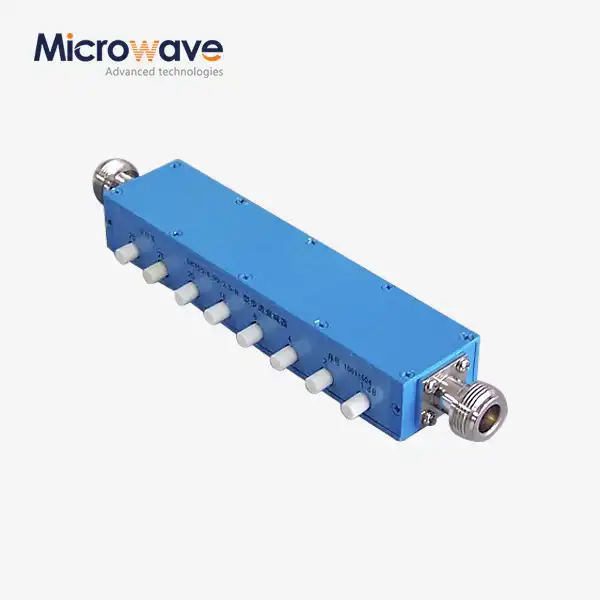
_1733809032116.webp)
